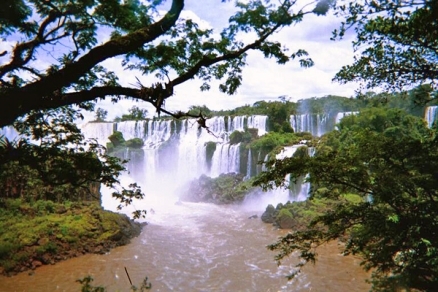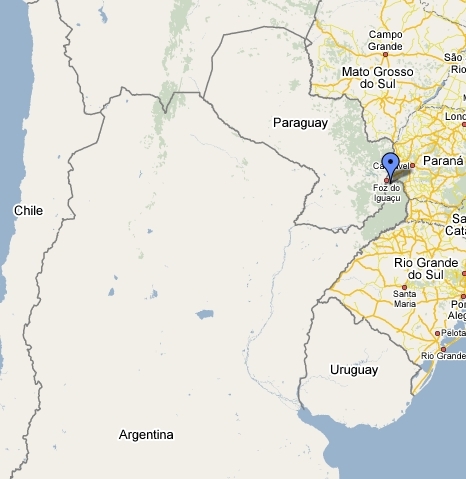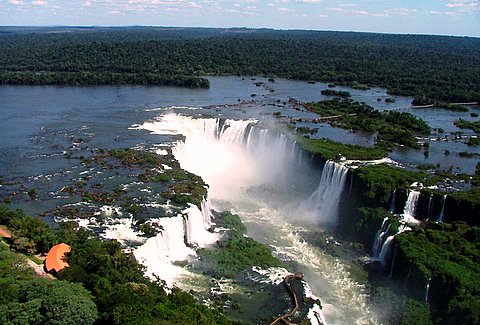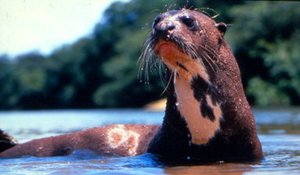Iguazú National Park, Argentina
| Topics: |
The Iguazú National Park (25°31'-25°43'S, 54°08'-54°32'W) is a World Heritage Site located in Northeastern Argentina.
Contents
- 1 Geographical location
- 2 Date and history of establishment
- 3 Area
- 4 Altitude
- 5 Physical features
- 6 Climate
- 7 Vegetation
- 8 Fauna
- 9 Cultural heritage
- 10 Local human population
- 11 Visitor and visitor facilities
- 12 Scientific research and facilities
- 13 Conservation value
- 14 Conservation management
- 15 IUCN management category
- 16 Further reading
Geographical location
The site (25°31'-25°43'S, 54°08'-54°32'W) consists of the national park and national reserve.
The park is located less than 5 kilometers (km) from the Paraguay border in Misiones Province, northeastern Argentina, with the reserve contiguous to the west.
The Iguazú River forms the northern boundary of both the reserve and park, and also the southern boundary of Iguaçu National Park in Brazil.
Date and history of establishment
- Officially established on 9 October 1934 by Decree-Law 12.103, although creation was concreted in September 1909 by Law 6.712.
- The area of the national reserve (between Puerto Iguazú and the waterfall) was excised from the park in 1970 by Decree-Law 18.801.
- Further modifications were made by Decree-Law 18.991 in 1971 (which removed the town of Puerto Iguazú from the park) and Decree-Law 19.478 in 1972 (which incorporated a further 12,600 hectares (ha) to the park).
- Inscribed on the World Heritage List in 1984.
Area
The total area is 55,000 ha, the National Park 49,200 ha, and National Reserve 6,300 ha.
Altitude
The altitude ranges from 150 meters (m) to 170 m.
Physical features
Iguazú National Park is part of a large plateau formed by basaltic lavas during the Mesozoic Era, more than 135 million years ago. Lava surfaced through tectonic faults and cracks, without formation of volcanic cones, and covered some one million square kilometers (km2) in Brazil, Paraguay, Argentina and Uruguay. The lava covered a broad portion of the Botucatu Triassic Desert and interleaved layers of sandstone and basalt have formed. The Iguazú River has its source in the Serra do Mar mountains at an elevation of 1,300 m, a short distance from the Atlantic Coast, and flows west for over 500 km into the Parana River, immediately to the west of Puerto Iguazú. The Iguazú Falls, located in the west of the park, are made up of 150-270 subsidiary falls depending on the flow rate, which seasonally varies between 300 cubic meters per second (m3/sec.) and 6,500 m3/sec.. The falls form a semi-circular front of 2,700 m, of which 800 m is under Brazilian jurisdiction. A proliferation of elongated islands, islets and rocks create numerous waterfalls which together form the large fan of the Iguazú Waterfalls. The falls drop an average of 72 m and the river immediately turns into a narrow, 80 m deep canyon, which has been enlarged by erosion of the basalt bedrock. The falls were probably initially located at the confluence of the Iguazú and Parana Rivers some 20,000 years ago, but erosion has caused them to recede 28 km upstream to their present location.
The remainder of the park is a gently undulating basalt plateau with a number of small rivers draining northwards into Iguazú River, notably the Central and Santo Domingo in valleys up to 60 m deep. There are a series of smaller islands, with Isla de San Agustin being the only one longer than 1 km.
Climate
Humid subtropical with hot summers. Annual mean temperature is 20°C: average summer and winter temperatures are 26°C and 14°C, respectively. During summer absolute maximum temperatures may exceed 42°C. Rainfall is abundant year round averaging 1,600 millimeters (mm) per annum. Relative humidity is high (75% to 90%) with fogs forming in winter or during the night.
Vegetation
Occupies the southernmost extremity of the Austro-Brazilian region in the Paranaense Province. The major formation is subtropical wet forest, rich in lianes and epiphytes. Several layers can be identified including emergent, large trees more than 30 m in height, intermediate-size trees, shrubs and an herbaceous ground flora. In total, some 2,000 species are present. A partial list has been published.
Three different plant associations can be distinguished. Firstly, laurel-guatambú forest whose main tree species include Balfourodendron riedelianum, Nectandra salgina, N. lanceolata, Cabralea oblongifolia, Lonchocarpus leucanthus, L. muehlbergianus, Enterolobium contortisiliquum and Tabebuia ipe. Understorey contains ferns (including tree fern Dicksonia selowiana), piperaceae, leguminosae, mirtaceae and bamboos. A great variety of climbing plants (compositae, bignoniaciae, and sapindaceae) already exists. Epiphytes include more than 60 species of orchids (Oncidium, Miltonia, Catasetum, and Warmingia, among other genera). Bromeliads are represented by genera Aechmea, Vriesea, Tillandsia, and others. Secondly, guatambú-laurel-palo rosa forest occurs in the highest sectors of the park to the southeast. Here it is common to find associations of Palo Rosa Aspidosperma polyneurum (V) and palmito Euterpe edulis (V) trees. Finally, there is the vegetation type associated with falls and nearby islands. Constant wetting due to spray and important levels of insolation determine a fairly distinctive flora, known as cupay forest Copaifera langsdorfii, with Anadenantera macrocarpa and Xilopia brasiliensis in the highest stratum. Higrophilus species such as Paspalum lilloi with Habenaria bractescens (orchid) and Dickya sp. form grasslands in the wettest areas close to the falls. In this habitat, aquatic plants such as Podostemon comata, P. aquirensis and Mourera aspera are found.
Fauna
The park is rich in fauna and includes 68 species of mammals, 422 of birds, 38 of reptiles, and 18 of amphibians, a large number of which are threatened or vulnerable. Mammals include giant otter Pteronura brasiliensis (V), La Plata otters Lutra platensis (V), jaguar Panthera onca, ocelot Felis pardalis, tiger-cat F. tigrina, jaguarundi F. yaguarundi (K), bush-dog Speothos venaticus (V), capuchin monkey Cebus apella, giant anteater Myrmecophaga tridactyla (V), tamandua Tamandua tetradactyla, crab-eating raccoon Procyon cancrivorus, coati Nasua nasua, and tapir Tapirus terrestris.
The park harbors approximately 44% of Argentina's avifauna, of which at least 180 species are resident. Species of particular concern are black-fronted piping guan Aburria jacutinga (E), Brazilian merganser Mergus octosetaceus (E), purple-winged ground dove Claravis godefrida (E) and helmeted woodpecker Dryocopus galeatus (V).
Reptiles include pit viper or urutú Bothrops alternatus, rattlesnake Crotalus durisus and Cyclagras gigas. A large population of spectacled caiman Caiman latirostris nest in the islands. Amphibians include Bufo marinus. Fish include leopard catfish Pimelodus maculatus and P. clarias.
Cultural heritage
The first inhabitants in the area were the Caingangues Indians. This tribe was dislodged by the Tupi-Guaranies who coined the name Iguazú, or "big water". The first European to reach the falls was the Spaniard Don Alvar Nuñes Cabeza de Vaca in 1541 and some ten years later Spanish and Portuguese colonization commenced. There are at least two sites of particular archaeological interest within the park.
Local human population
Currently, there are no settlers within the park. However, being located in a region of rapid population growth, it is foreseeable that the park's limits will suffer growing population pressure from Argentina, and neighboring Brazil and Paraguay.
Visitor and visitor facilities
In 1993, there were approximately 530,300 visitors to the park, the highest concentration being during the Holy Week, when about 10,300 people visited. Facilities include an international airport, hotel, youth camp, camp and picnic grounds, kiosks, restaurants, an extensive network of trails, boat trips and a small museum in the administrative center located in Puerto Iguazú. Facilities are also available in Puerto Iguazú. An ambitious plan to improve existing facilities was recently prepared and includes building a new information center, signpost trails and the relocation of bars and restaurants.
Scientific research and facilities
The waterfalls and their environs have been studied since the end of the last century. Increasing the size of the park to improve the long term survival of species such as tapir, peccary, and jaguar, has been suggested in several studies. A bibliography is given in the World Heritage nomination. During 1994, an environmental impact assessment was carried out in conjunction with the proposal to improve facilities. A Centre for Subtropical Research (Centro de Investigaciones Tropicales) was established in 1988. The Centre is responsible for any scientific research programs within the park. The newly created Delegación Técnica Regional NEA (Technical Delegation for the Northeastern Region) is also based in the park, and coordinates conservation and research activities, not only for Iguazú but also for other protected areas in the region.
Conservation value
Iguazú harbors one the most complete remnant patches of the highly endangered (IUCN Red List Criteria for Endangered) Paranaense forest (in Brazil and Paraguay only 5-10% of the original area of this ecosystem remains). Comprises one of the most biologically diverse parks in Argentina containing almost 44% of Argentina's avifauna and several threatened mammals.
Conservation management
A management plan has been prepared although its implementation is weak. A corrective contingent operative plan for the period 1995-1996 has been prepared.
Management constraints
Selective forest exploitation has occurred in the area in the past. Both the reserve and the national park are transected by national highways and approximately 100 ha of land in the extreme north-west of the reserve is occupied by a military base. The construction of dams upstream in Brazil has been proposed. There is intensive tourist use, but this is largely concentrated around the waterfalls. Proposals have been made to transfer some 23% of the park to the provincial authorities, and to allow greater development of facilities at the falls area. Iguazú is the terminal area of a large water catchment (Watershed) basin whose headwaters are subject to intensive and largely uncontrolled use which may adversely effect the park. The park itself is subject to increasing use and alteration in marginal areas.
Staff
A total of 51 staff in 1994, including 21 rangers, five researchers and 25 administrators.
Budget
US$404,541 for 1994, excluding salaries (which were estimated in US$15,500 per year).
IUCN management category
- II (National Park)
- IV (Habitat/Species Management Area)
- Natural World Heritage Site - Criteria iii, iv
Further reading
- Anon. (1983). World Heritage Nomination: Parc National Iguazu. Direction des Parcs Nationaux. 45 pp.
- Anon. (not dated a). Lista de los mamiferos del Parque Nacional Iguazu. Safari Fotografico. Puerto Iguazu. Leaflet.
- Anon. (not dated b). Lista de las aves del Parque Nacional Iguazu. 6 pp.
- Anon. (1978). Lista de especies vegetales interpretadas: Parque Nacional Iguazu. Guembe Cataratas Tours. Puerto Iguazu. Leaflet.
- Cinti, R.R. (1983). Parque Nacional Iguazu. Administracion de Parques Nacionales, Ministerio de Economia. Editorial ABRIL S.A., Buenos Aires. 18 pp.
- Erize, F. (1986). Iguazu: un parque en peligro. Vida Silvestre 19: 44-47.
- Erize, F., Canevari, M., Canevari, P., Costa, G. y Rumboll, M. Los parque nacionales de la Argentina y otras de sus areas protegidas. INCAFO, Madrid, Spain. 238 pp.
- Giudice, L.A., Echechuri, H.A. and Prudkin, N. (1988). Plan de manejo: Parque Nacional Iguazu. Administracion de Parques Nacionales/FAO/UNDP.
- Groombridge, B. (ed.) (1993). 1994 IUCN List of threatened animals. IUCN, Gland, Switzerland and Cambridge, UK. lvi + 286 pp. ISBN: 2831701945.
- Honacki, J.H., Kinman, K.E., and Koeppl, J.W. (1982). Mammal species of the world: a taxonomic and geographic reference. Allen Press and the Association of Systematics Collections, Lawrence, Kansas, USA. 694 pp.
- Howard, R. and Moore, A. (1980). A complete checklist of the birds of the world. Macmillan, London, UK. 732 pp. ISBN: 0691117012.
- Malvarez, A.I. (1988). Plan de manejo del Parque Nacional Iguazu: evaluacion ecologica del medio natural. Proyecto y gestion de los parques nacionales (APN-FAO). 10 pp.
| Disclaimer: This article is taken wholly from, or contains information that was originally published by, the United Nations Environment Programme-World Conservation Monitoring Centre (UNEP-WCMC). Topic editors and authors for the Encyclopedia of Earth may have edited its content or added new information. The use of information from the United Nations Environment Programme-World Conservation Monitoring Centre (UNEP-WCMC) should not be construed as support for or endorsement by that organization for any new information added by EoE personnel, or for any editing of the original content. |



